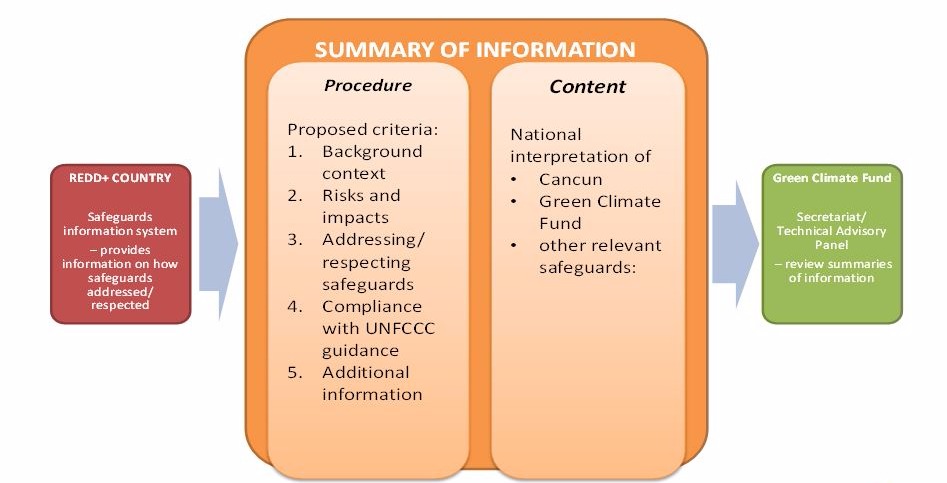The Green Climate Fund, financing arm of the United Nations Framework Convention on Climate Change, is moving rapidly towards paying developing countries to protect, conserve and restore their tropical forests through the mechanism known as REDD+. A cornerstone of the Convention’s rulebook on REDD+ is safeguards; principles - on governance, indigenous peoples, biodiversity, etc. - of how REDD+ is supposed to be implemented. In addition to having a national-level safeguards information system in place, countries have to report how they are addressing and respecting these safeguards in a ‘summary of information’ before payments for emission reductions can be made.
Unlike reference levels for carbon accounting, there is no requirement under the Convention for these summaries to be formally reviewed. Consequently, there is a risk that summaries of information could be viewed as something of a box-ticking exercise contributing to eligibility for results-based payments. Yet every donor, or fund, making result-based payments will need to ensure environmental and social due diligence of REDD+ actions before any payments are made for tonnes of carbon.
In April 2017, the Green Climate Fund convened an experts’ workshop in Bali to work towards enabling imminent payments for REDD+ results and make the forest part of the Paris Agreement operational. Three key questions related to safeguards for REDD+ were raised:
-
how to assess summaries of safeguards information submitted by countries to the Climate Change Convention;
-
how to include Green Climate Fund environmental and social safeguards in the overall assessment of these summaries; and
-
how to reconcile the Convention’s Cancun safeguards and those of the Green Climate Fund?
The answers to these questions are, of course, complex. The safeguards of the Convention (UNFCCC) and those of the Green Climate Fund are not the same, which poses problems if you are trying to reconcile the two in order to assess summaries of information with a single harmonised framework. Indeed, these two safeguards frameworks were designed to do distinctly different jobs. The Green Climate Fund has adopted the International Finance Corporation’s Performance Standards, which were originally designed to give (50 pages of) prescriptive procedural guidance to private sector clients in managing risk through their daily business practices. The Cancun safeguards, on the other hand, were negotiated as a set of broad principles (seven sentences) for nation states to abide by when it comes to implementing REDD+. It’s a case of reconciling apples and oranges, despite the superficial similarity of both being labelled ‘safeguards’.
Complicating matters is the fact that these two safeguards frameworks are not the only ones applied to REDD+; other funding initiatives, such as the Forest Carbon Partnership Facility, have their own safeguards frameworks and requirements. And although the Cancun safeguards provide the substantive content countries must abide by, the Convention does not offer any operational guidance on procedures of how to go about doing this in practice. Responding to the different safeguards requirements of various REDD+ initiatives has, thus far, proven to be a challenge for REDD+ countries.
Lacking operational guidance, and in an attempt to find synergies between different safeguards requirements, a growing number of countries have adopted ‘country approaches to safeguards’ that identify, assess and strengthen existing policies, laws, regulations, institutions and information systems, which can be employed to address and respect safeguards. In addition to meeting the Convention’s requirements, country approaches can incorporate other safeguards requirements, such as those of the Green Climate Fund and other specific funds and donors looking to make results-based payments.
As a contribution to the dialogue on how the Green Climate Fund could get REDD+ operational, and drawing on the experiences acquired by the UN-REDD Programme in supporting country approaches to safeguards, UN Environment has been looking into how safeguards could be reviewed for REDD+ results-based payments under the Green Climate Fund. How to make reviewing a challenging and complex safeguards situation simple…or at least as simple as possible…?
The suggested review framework (Figure 1) combines the benefits of looking at both progress and performance against multiple safeguards requirements:
-
a checklist of procedural safeguards steps, to help assess country progress on meeting safeguards requirements, taking account good practice safeguard procedures to meet Convention requirements, in addition to those of other entities making payments for results; and
-
a checklist of substantive safeguards content, to help assess country performance, in terms of achieving both ‘do no harm’ and ‘do good’ outcomes to meet multiple safeguards, reconciled through an international legal good practice interpretation of the Cancun safeguards (see Table 6 in ‘Towards a common understanding of REDD+ under the UNFCCC’).

The relative simplicity of this framework lies in its grounding in existing safeguards rules of the Convention and Green Climate Fund, as well as in the existing practices of countries trying to follow these rules. This framework avoids additional safeguards, which could further burden countries, and puts an emphasis on continual assessment, from one summary of information to another, which could stimulate the incremental improvements in safeguards performance expected of REDD+ countries.
Three countries – Brazil, Ecuador and Malaysia – have already submitted their first safeguards summaries to the Convention. A handful of other countries are working on their first summaries now with a view to submission later this year. Once Green Climate Fund safeguards requirements are defined, it is anticipated that countries will also seek to include these in their summaries of information. Review of safeguards information is on the horizon. It is time for countries to look beyond what was negotiated in Cancun and start racing to the top, in terms of the quality of their summaries, when it comes to accessing payments for REDD+ results. The Green Climate Fund can stimulate countries to do this by making review of safeguards as simple as possible but, in the interests of REDD+’s environmental and social integrity, no simpler.


